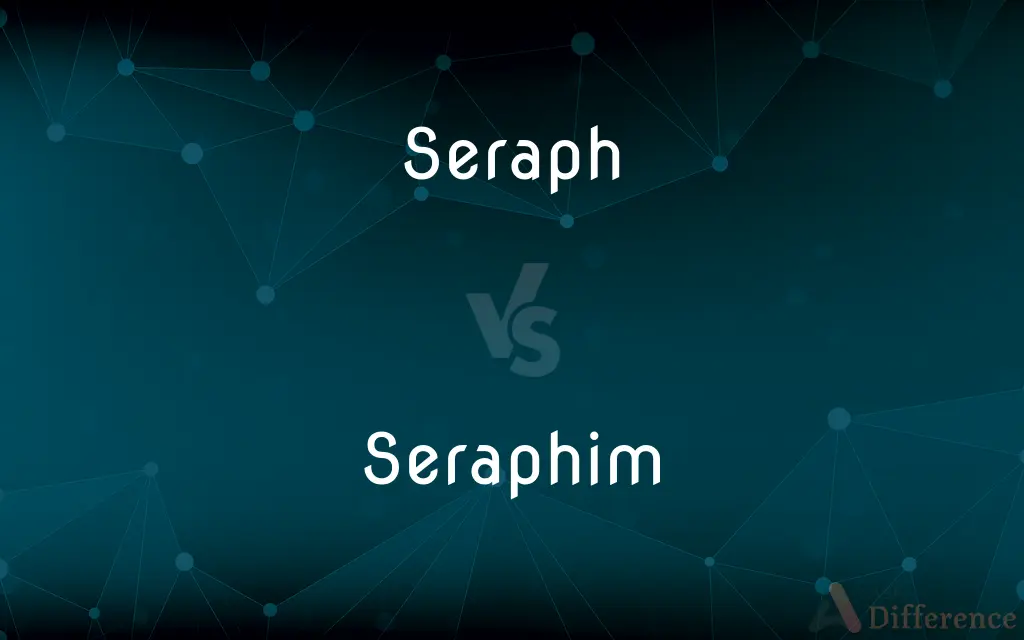Seraph vs. Seraphim — What's the Difference?
Edited by Tayyaba Rehman — By Maham Liaqat — Updated on March 19, 2024
A seraph is a singular heavenly being, whereas seraphim refers to the plural form of these celestial entities.

Difference Between Seraph and Seraphim
Table of Contents
ADVERTISEMENT
Key Differences
Seraphs are often depicted as the highest order of angelic beings in various religious texts, known for their purity and closeness to the divine. They are typically described as having six wings and are associated with the worship and praise of God. Whereas seraphim is simply the plural term used when referring to more than one seraph, indicating the presence of multiple such beings in religious narratives.
In art and literature, a seraph is usually portrayed as a figure of light and fire, embodying the flame of divine love and the illumination of God's truth. On the other hand, seraphim are often depicted together in groups, surrounding the throne of God or engaging in acts of worship, highlighting their collective role in the celestial hierarchy.
The term seraph emphasizes the individual qualities and roles of these angelic beings, such as their direct service to the deity and their embodiment of love and light. Seraphim, however, stresses the communal aspect, showcasing how these entities operate as a collective in their adoration and service to the divine.
While a seraph's depiction focuses on its singular divine mission and attributes, seraphim as a group reflect the diversity and unity within the highest echelons of angelic beings, each contributing to the harmonious worship of the divine with their unique qualities.
Understanding the distinction between seraph and seraphim is crucial for interpreting religious texts and artworks accurately, as it affects the portrayal and interpretation of these celestial beings' roles and significance in the divine realm.
ADVERTISEMENT
Comparison Chart
Number
Singular
Plural
Depiction
Individual celestial being
Group of celestial beings
Emphasis
Individual qualities and roles
Collective worship and service
Role in narratives
Direct service to the deity, embodiment of divine love
Group adoration and service to the divine
Interpretation in art and literature
Individual mission and attributes
Diversity and unity within celestial hierarchy
Compare with Definitions
Seraph
A seraph is a high-ranking angelic being known for its purity and closeness to God, often depicted with six wings.
In the vision, the prophet saw a seraph touching his lips with a burning coal.
Seraphim
Seraphim are the plural form of seraph, referring to a group of high-ranking angelic beings in celestial hierarchies.
The seraphim gathered around the throne, their voices in unison praising the Almighty.
Seraph
Seraphs serve as messengers of God, bringing divine revelations and executing divine will.
The seraph appeared to the faithful, delivering a message of hope and divine guidance.
Seraphim
Seraphim are often depicted as a collective, engaging in the communal worship and adoration of God.
The painting showed the seraphim in a circle of light, their songs filling the heavens.
Seraph
Seraphs are mentioned in religious texts, such as the Bible, in contexts highlighting their role in divine worship.
The text described a seraph singing praises and worshiping God ceaselessly.
Seraphim
Seraphim represent the multitude of ways divine love and light manifest in the celestial realm.
The mosaic depicted the seraphim with diverse colors, each representing a facet of divine love.
Seraph
In various cultures, a seraph is often associated with light, fire, and the ethereal aspects of the divine.
The sculpture depicted a seraph with radiant wings, symbolizing its heavenly nature.
Seraphim
In some beliefs, seraphim play a significant role in eschatological events, acting as guardians of God's throne.
The prophecy spoke of seraphim standing guard, ensuring the sanctity of the divine throne.
Seraph
A seraph symbolizes divine love, illumination, and the fiery purity of God's presence.
The artist's portrayal of the seraph embodied the fiery spirit of divine love.
Seraphim
Despite being a collective, each of the seraphim may possess unique attributes contributing to their communal role.
Among the seraphim, each had distinct wings, yet all shared the same divine purpose.
Seraph
A seraph (, "the burning one"; plural seraphim ) is a type of celestial or heavenly being originating in Ancient Judaism. The term plays a role in subsequent Judaism, Christianity, and Islam.Tradition places seraphim in the highest rank in Christian angelology and in the fifth rank of ten in the Jewish angelic hierarchy.
Seraphim
(Bible) A celestial being having three pairs of wings.
Seraph
(Bible) A celestial being having three pairs of wings.
Seraphim
Seraphim(Christianity) The first of the nine orders of angels in medieval angelology.
Seraph
Seraphim(Christianity) The first of the nine orders of angels in medieval angelology.
Seraphim
Plural of seraph
Seraph
(biblical) A six-winged angel; one of the highest choir or order of angels in Christian angelology, ranked above cherubim, and below God. They are the 5th-highest order of angels in Jewish angelology. A detailed description can be found at the beginning of [http://en.wikisource.org/wiki/Bible_%28World_English%29/Isaiah#Chapter_6 Isaiah chapter 6].
Seraphim
Lobophora halterata, a species of Geometrid moth.
Seraph
One of an order of celestial beings, each having three pairs of wings. In ecclesiastical art and in poetry, a seraph is represented as one of a class of angels.
As full, as perfect, in vile man that mourns,As the rapt seraph that adores and burns.
Seraphim
The Hebrew plural of Seraph. Cf. Cherubim.
Seraph
An angel of the first order; usually portrayed as the winged head of a child
Common Curiosities
Can seraphim have individual characteristics?
While seraphim act as a collective, individual members may have unique qualities contributing to their group role.
Are seraphim always depicted in groups?
Yes, seraphim are typically shown as a collective, emphasizing their role in communal worship and service to God.
How do seraphim differ from a single seraph?
Seraphim is the plural form of seraph, referring to a group of these celestial beings rather than an individual.
What is the significance of the six wings of a seraph?
The six wings of a seraph symbolize their sublime holiness and their ability to serve God in various capacities.
How do seraphim contribute to the harmony of the celestial realm?
Seraphim contribute by their unified worship and service, reflecting the harmony and order of the celestial hierarchy.
What does a seraph symbolize?
A seraph symbolizes the fiery purity of God's presence, divine love, and the illumination of God's truth.
What is a seraph?
A seraph is a high-ranking angelic being, often associated with divine love and purity, depicted with six wings.
What roles do seraphs play in religious texts?
Seraphs are depicted as messengers of God, involved in divine worship and the execution of God's will.
Do seraphim appear in religious ceremonies or rituals?
In some traditions, seraphim are invoked or symbolically represented in religious ceremonies to signify divine presence and worship.
How are seraphs portrayed in art?
Seraphs are often depicted with radiant wings, embodying light and fire, to represent their divine nature.
Do seraphim have a specific role in the hierarchy of angels?
Yes, seraphim are considered among the highest orders of angels, closely associated with the throne of God.
Is there a difference in the way seraphs and seraphim are worshiped or venerated?
Worship or veneration practices may vary, but typically focus on their collective role in divine adoration rather than individual worship.
In what contexts do seraphs appear in religious narratives?
Seraphs appear in contexts involving divine revelations, worship, and the execution of divine commands.
Share Your Discovery

Previous Comparison
Gust vs. Squall
Next Comparison
Publisher vs. PublicationAuthor Spotlight
Written by
Maham LiaqatEdited by
Tayyaba RehmanTayyaba Rehman is a distinguished writer, currently serving as a primary contributor to askdifference.com. As a researcher in semantics and etymology, Tayyaba's passion for the complexity of languages and their distinctions has found a perfect home on the platform. Tayyaba delves into the intricacies of language, distinguishing between commonly confused words and phrases, thereby providing clarity for readers worldwide.
















































